Saroj Kharel: Quality Management in Hospitality Assignment Report
VerifiedAdded on 2022/03/08
|73
|22013
|10
Report
AI Summary
This report, submitted by Saroj Kharel to ISMT College in 2017, comprehensively examines quality management within the hospitality industry. It covers a wide range of topics, starting with definitions of quality in business and service provision, then moving on to inspection and assurance processes. The report delves into various approaches to quality management, including the process approach and elements of quality management. It explores customer satisfaction, continuous improvement strategies, and the value added in hospitality, providing relevant examples. Furthermore, the report discusses information made available to customers, effective marketing strategies, and methods for measuring quality management, including ISO 9000 and TQM. It evaluates the benefits of surveys, methods of consultation, and the use of complaints procedures to improve quality. The report concludes with an examination of self-assessment, the importance of communication and record keeping, staff consultation stages, and proposes systems to enhance service quality. The report is a comprehensive overview of quality management principles and practices within the hospitality sector.
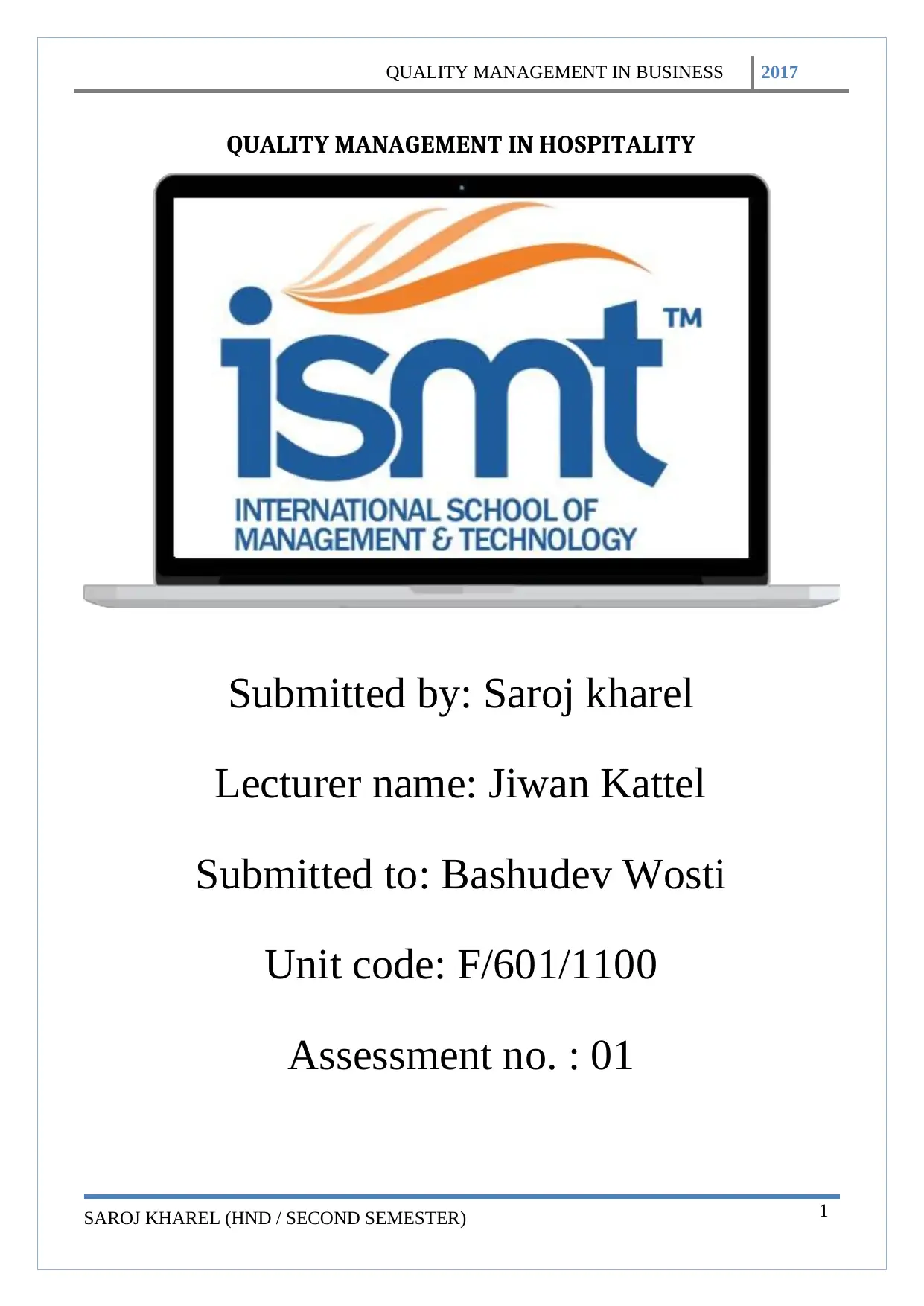
QUALITY MANAGEMENT IN BUSINESS 2017
SAROJ KHAREL (HND / SECOND SEMESTER) 1
QUALITY MANAGEMENT IN HOSPITALITY
Submitted by: Saroj kharel
Lecturer name: Jiwan Kattel
Submitted to: Bashudev Wosti
Unit code: F/601/1100
Assessment no. : 01
SAROJ KHAREL (HND / SECOND SEMESTER) 1
QUALITY MANAGEMENT IN HOSPITALITY
Submitted by: Saroj kharel
Lecturer name: Jiwan Kattel
Submitted to: Bashudev Wosti
Unit code: F/601/1100
Assessment no. : 01
Paraphrase This Document
Need a fresh take? Get an instant paraphrase of this document with our AI Paraphraser
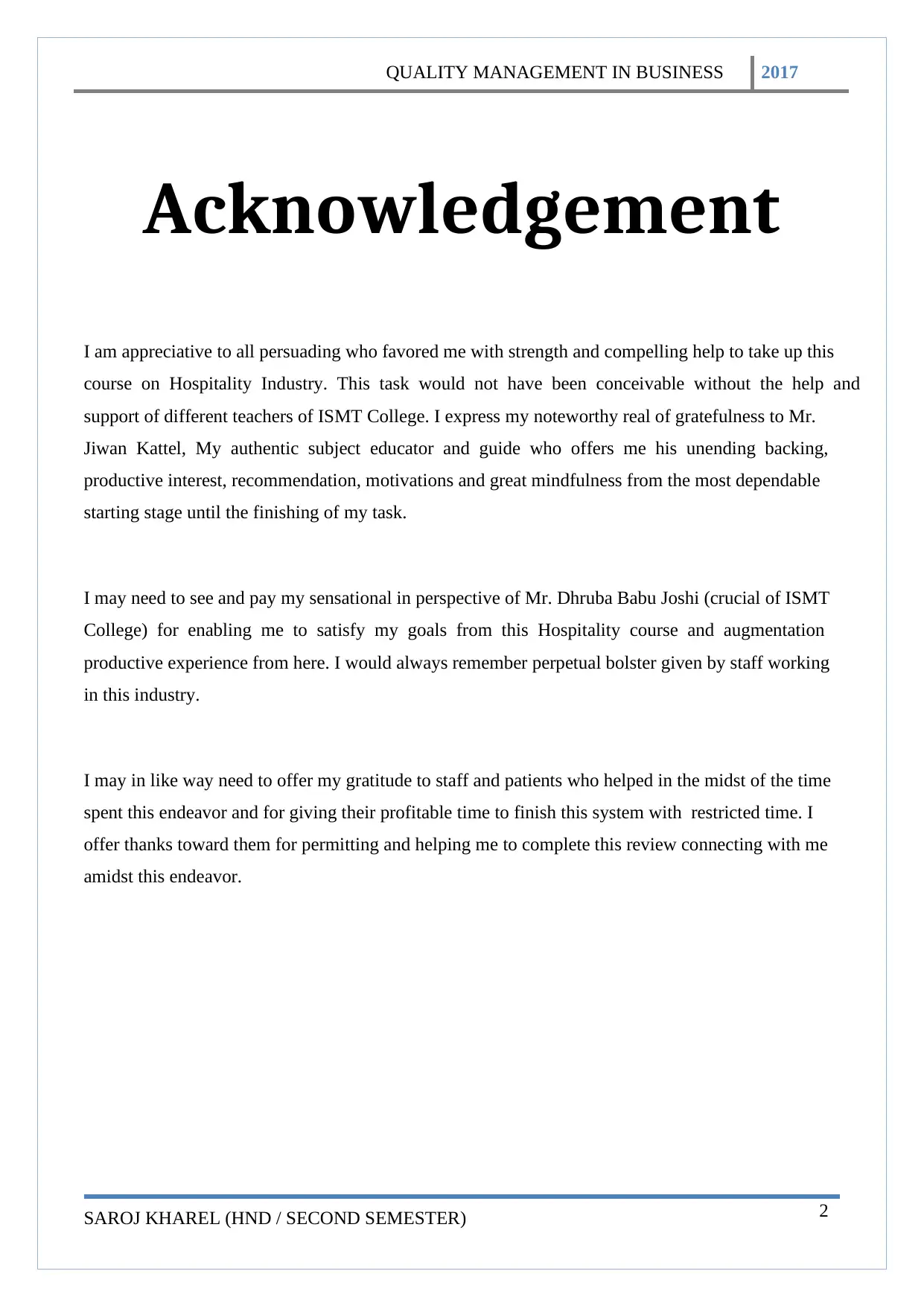
QUALITY MANAGEMENT IN BUSINESS 2017
SAROJ KHAREL (HND / SECOND SEMESTER) 2
Acknowledgement
I am appreciative to all persuading who favored me with strength and compelling help to take up this
course on Hospitality Industry. This task would not have been conceivable without the help and
support of different teachers of ISMT College. I express my noteworthy real of gratefulness to Mr.
Jiwan Kattel, My authentic subject educator and guide who offers me his unending backing,
productive interest, recommendation, motivations and great mindfulness from the most dependable
starting stage until the finishing of my task.
I may need to see and pay my sensational in perspective of Mr. Dhruba Babu Joshi (crucial of ISMT
College) for enabling me to satisfy my goals from this Hospitality course and augmentation
productive experience from here. I would always remember perpetual bolster given by staff working
in this industry.
I may in like way need to offer my gratitude to staff and patients who helped in the midst of the time
spent this endeavor and for giving their profitable time to finish this system with restricted time. I
offer thanks toward them for permitting and helping me to complete this review connecting with me
amidst this endeavor.
SAROJ KHAREL (HND / SECOND SEMESTER) 2
Acknowledgement
I am appreciative to all persuading who favored me with strength and compelling help to take up this
course on Hospitality Industry. This task would not have been conceivable without the help and
support of different teachers of ISMT College. I express my noteworthy real of gratefulness to Mr.
Jiwan Kattel, My authentic subject educator and guide who offers me his unending backing,
productive interest, recommendation, motivations and great mindfulness from the most dependable
starting stage until the finishing of my task.
I may need to see and pay my sensational in perspective of Mr. Dhruba Babu Joshi (crucial of ISMT
College) for enabling me to satisfy my goals from this Hospitality course and augmentation
productive experience from here. I would always remember perpetual bolster given by staff working
in this industry.
I may in like way need to offer my gratitude to staff and patients who helped in the midst of the time
spent this endeavor and for giving their profitable time to finish this system with restricted time. I
offer thanks toward them for permitting and helping me to complete this review connecting with me
amidst this endeavor.
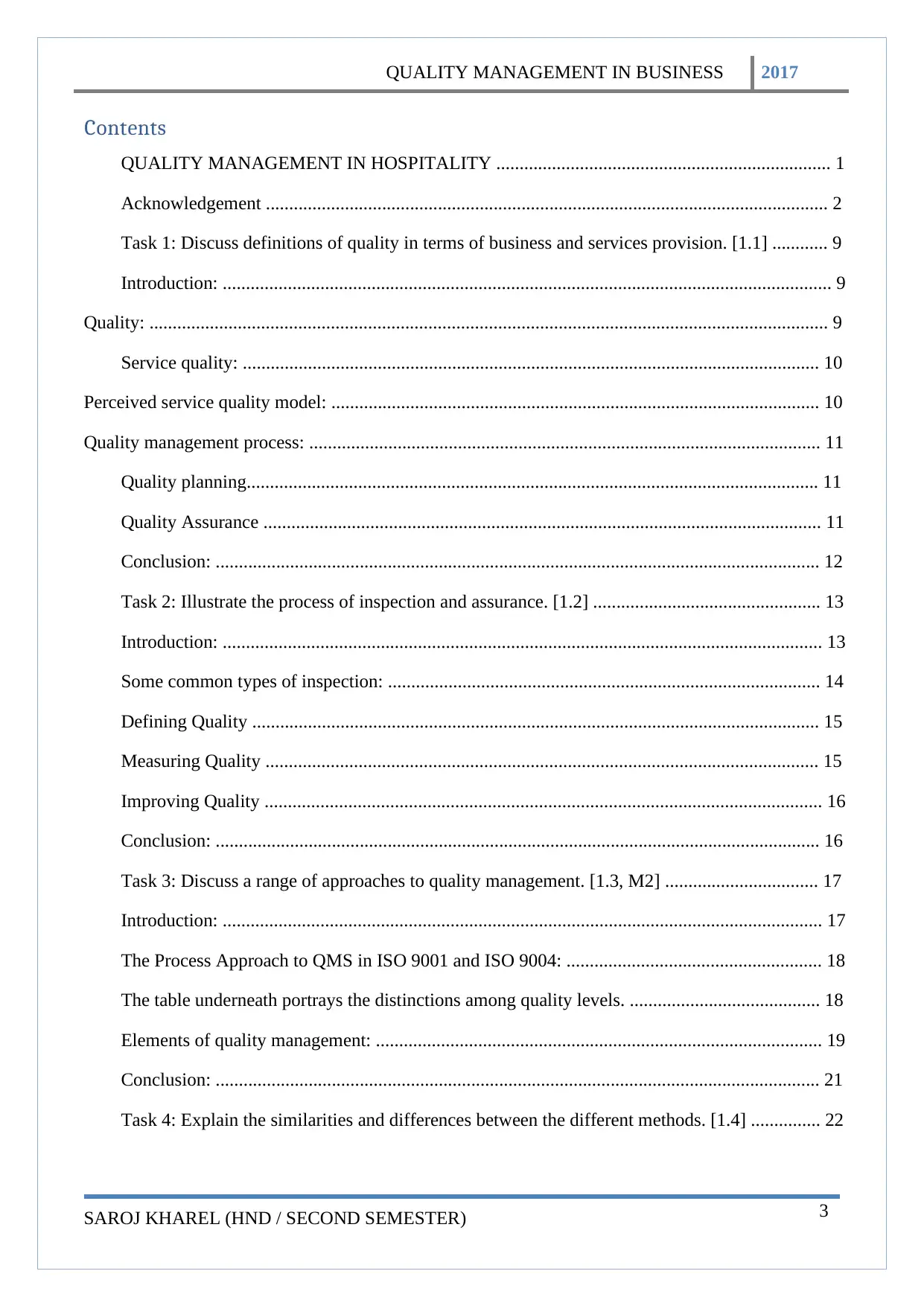
QUALITY MANAGEMENT IN BUSINESS 2017
SAROJ KHAREL (HND / SECOND SEMESTER) 3
Contents
QUALITY MANAGEMENT IN HOSPITALITY ........................................................................ 1
Acknowledgement ......................................................................................................................... 2
Task 1: Discuss definitions of quality in terms of business and services provision. [1.1] ............ 9
Introduction: ................................................................................................................................... 9
Quality: .................................................................................................................................................. 9
Service quality: ............................................................................................................................ 10
Perceived service quality model: ......................................................................................................... 10
Quality management process: .............................................................................................................. 11
Quality planning........................................................................................................................... 11
Quality Assurance ........................................................................................................................ 11
Conclusion: .................................................................................................................................. 12
Task 2: Illustrate the process of inspection and assurance. [1.2] ................................................. 13
Introduction: ................................................................................................................................. 13
Some common types of inspection: ............................................................................................. 14
Defining Quality .......................................................................................................................... 15
Measuring Quality ....................................................................................................................... 15
Improving Quality ........................................................................................................................ 16
Conclusion: .................................................................................................................................. 16
Task 3: Discuss a range of approaches to quality management. [1.3, M2] ................................. 17
Introduction: ................................................................................................................................. 17
The Process Approach to QMS in ISO 9001 and ISO 9004: ....................................................... 18
The table underneath portrays the distinctions among quality levels. ......................................... 18
Elements of quality management: ................................................................................................ 19
Conclusion: .................................................................................................................................. 21
Task 4: Explain the similarities and differences between the different methods. [1.4] ............... 22
SAROJ KHAREL (HND / SECOND SEMESTER) 3
Contents
QUALITY MANAGEMENT IN HOSPITALITY ........................................................................ 1
Acknowledgement ......................................................................................................................... 2
Task 1: Discuss definitions of quality in terms of business and services provision. [1.1] ............ 9
Introduction: ................................................................................................................................... 9
Quality: .................................................................................................................................................. 9
Service quality: ............................................................................................................................ 10
Perceived service quality model: ......................................................................................................... 10
Quality management process: .............................................................................................................. 11
Quality planning........................................................................................................................... 11
Quality Assurance ........................................................................................................................ 11
Conclusion: .................................................................................................................................. 12
Task 2: Illustrate the process of inspection and assurance. [1.2] ................................................. 13
Introduction: ................................................................................................................................. 13
Some common types of inspection: ............................................................................................. 14
Defining Quality .......................................................................................................................... 15
Measuring Quality ....................................................................................................................... 15
Improving Quality ........................................................................................................................ 16
Conclusion: .................................................................................................................................. 16
Task 3: Discuss a range of approaches to quality management. [1.3, M2] ................................. 17
Introduction: ................................................................................................................................. 17
The Process Approach to QMS in ISO 9001 and ISO 9004: ....................................................... 18
The table underneath portrays the distinctions among quality levels. ......................................... 18
Elements of quality management: ................................................................................................ 19
Conclusion: .................................................................................................................................. 21
Task 4: Explain the similarities and differences between the different methods. [1.4] ............... 22
⊘ This is a preview!⊘
Do you want full access?
Subscribe today to unlock all pages.

Trusted by 1+ million students worldwide
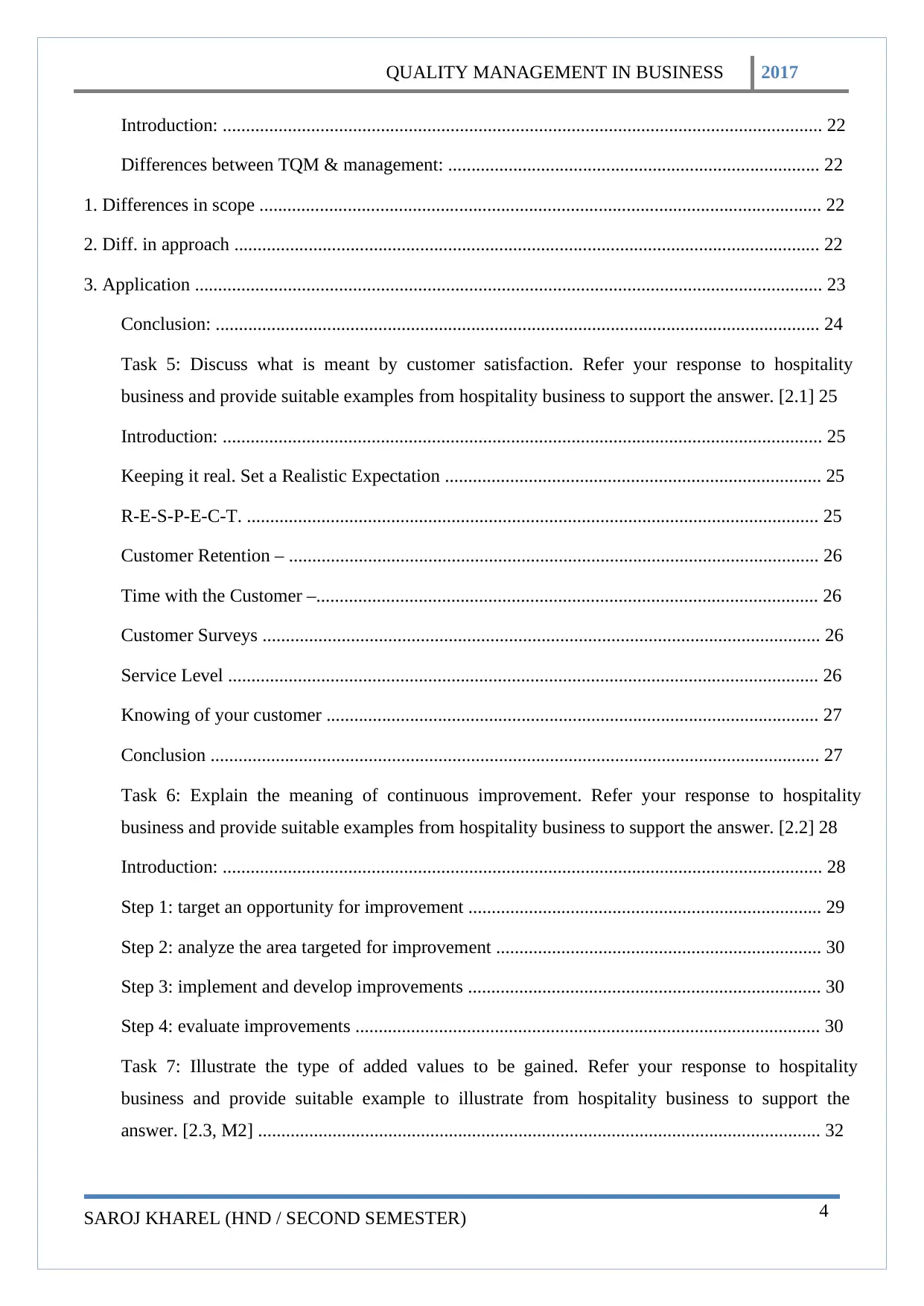
QUALITY MANAGEMENT IN BUSINESS 2017
SAROJ KHAREL (HND / SECOND SEMESTER) 4
Introduction: ................................................................................................................................. 22
Differences between TQM & management: ................................................................................ 22
1. Differences in scope ......................................................................................................................... 22
2. Diff. in approach .............................................................................................................................. 22
3. Application ....................................................................................................................................... 23
Conclusion: .................................................................................................................................. 24
Task 5: Discuss what is meant by customer satisfaction. Refer your response to hospitality
business and provide suitable examples from hospitality business to support the answer. [2.1] 25
Introduction: ................................................................................................................................. 25
Keeping it real. Set a Realistic Expectation ................................................................................. 25
R-E-S-P-E-C-T. ........................................................................................................................... 25
Customer Retention – .................................................................................................................. 26
Time with the Customer –............................................................................................................ 26
Customer Surveys ........................................................................................................................ 26
Service Level ............................................................................................................................... 26
Knowing of your customer .......................................................................................................... 27
Conclusion ................................................................................................................................... 27
Task 6: Explain the meaning of continuous improvement. Refer your response to hospitality
business and provide suitable examples from hospitality business to support the answer. [2.2] 28
Introduction: ................................................................................................................................. 28
Step 1: target an opportunity for improvement ............................................................................ 29
Step 2: analyze the area targeted for improvement ...................................................................... 30
Step 3: implement and develop improvements ............................................................................ 30
Step 4: evaluate improvements .................................................................................................... 30
Task 7: Illustrate the type of added values to be gained. Refer your response to hospitality
business and provide suitable example to illustrate from hospitality business to support the
answer. [2.3, M2] ......................................................................................................................... 32
SAROJ KHAREL (HND / SECOND SEMESTER) 4
Introduction: ................................................................................................................................. 22
Differences between TQM & management: ................................................................................ 22
1. Differences in scope ......................................................................................................................... 22
2. Diff. in approach .............................................................................................................................. 22
3. Application ....................................................................................................................................... 23
Conclusion: .................................................................................................................................. 24
Task 5: Discuss what is meant by customer satisfaction. Refer your response to hospitality
business and provide suitable examples from hospitality business to support the answer. [2.1] 25
Introduction: ................................................................................................................................. 25
Keeping it real. Set a Realistic Expectation ................................................................................. 25
R-E-S-P-E-C-T. ........................................................................................................................... 25
Customer Retention – .................................................................................................................. 26
Time with the Customer –............................................................................................................ 26
Customer Surveys ........................................................................................................................ 26
Service Level ............................................................................................................................... 26
Knowing of your customer .......................................................................................................... 27
Conclusion ................................................................................................................................... 27
Task 6: Explain the meaning of continuous improvement. Refer your response to hospitality
business and provide suitable examples from hospitality business to support the answer. [2.2] 28
Introduction: ................................................................................................................................. 28
Step 1: target an opportunity for improvement ............................................................................ 29
Step 2: analyze the area targeted for improvement ...................................................................... 30
Step 3: implement and develop improvements ............................................................................ 30
Step 4: evaluate improvements .................................................................................................... 30
Task 7: Illustrate the type of added values to be gained. Refer your response to hospitality
business and provide suitable example to illustrate from hospitality business to support the
answer. [2.3, M2] ......................................................................................................................... 32
Paraphrase This Document
Need a fresh take? Get an instant paraphrase of this document with our AI Paraphraser
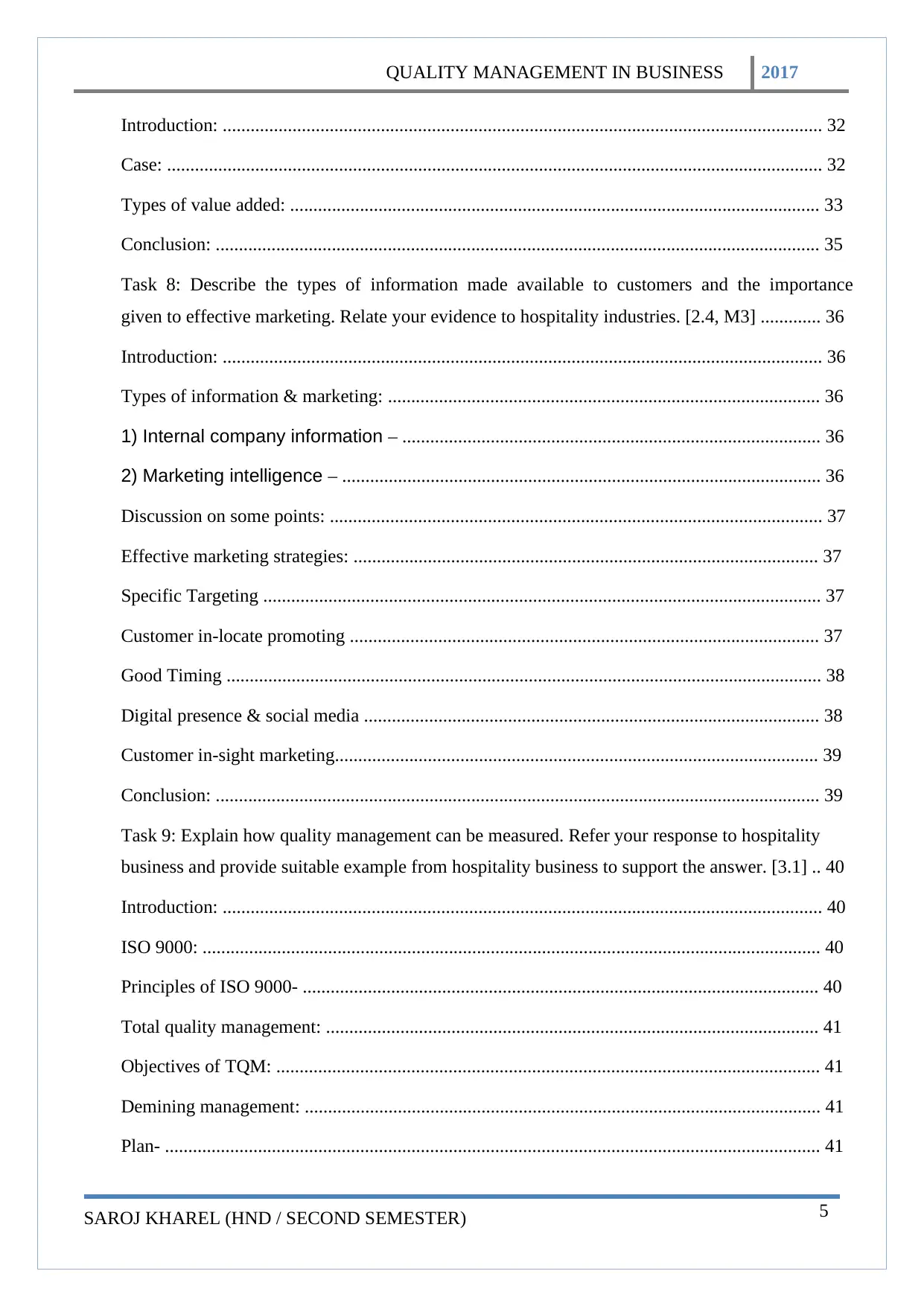
QUALITY MANAGEMENT IN BUSINESS 2017
SAROJ KHAREL (HND / SECOND SEMESTER) 5
Introduction: ................................................................................................................................. 32
Case: ............................................................................................................................................. 32
Types of value added: .................................................................................................................. 33
Conclusion: .................................................................................................................................. 35
Task 8: Describe the types of information made available to customers and the importance
given to effective marketing. Relate your evidence to hospitality industries. [2.4, M3] ............. 36
Introduction: ................................................................................................................................. 36
Types of information & marketing: ............................................................................................. 36
1) Internal company information – .......................................................................................... 36
2) Marketing intelligence – ....................................................................................................... 36
Discussion on some points: .......................................................................................................... 37
Effective marketing strategies: .................................................................................................... 37
Specific Targeting ........................................................................................................................ 37
Customer in-locate promoting ..................................................................................................... 37
Good Timing ................................................................................................................................ 38
Digital presence & social media .................................................................................................. 38
Customer in-sight marketing........................................................................................................ 39
Conclusion: .................................................................................................................................. 39
Task 9: Explain how quality management can be measured. Refer your response to hospitality
business and provide suitable example from hospitality business to support the answer. [3.1] .. 40
Introduction: ................................................................................................................................. 40
ISO 9000: ..................................................................................................................................... 40
Principles of ISO 9000- ............................................................................................................... 40
Total quality management: .......................................................................................................... 41
Objectives of TQM: ..................................................................................................................... 41
Demining management: ............................................................................................................... 41
Plan- ............................................................................................................................................. 41
SAROJ KHAREL (HND / SECOND SEMESTER) 5
Introduction: ................................................................................................................................. 32
Case: ............................................................................................................................................. 32
Types of value added: .................................................................................................................. 33
Conclusion: .................................................................................................................................. 35
Task 8: Describe the types of information made available to customers and the importance
given to effective marketing. Relate your evidence to hospitality industries. [2.4, M3] ............. 36
Introduction: ................................................................................................................................. 36
Types of information & marketing: ............................................................................................. 36
1) Internal company information – .......................................................................................... 36
2) Marketing intelligence – ....................................................................................................... 36
Discussion on some points: .......................................................................................................... 37
Effective marketing strategies: .................................................................................................... 37
Specific Targeting ........................................................................................................................ 37
Customer in-locate promoting ..................................................................................................... 37
Good Timing ................................................................................................................................ 38
Digital presence & social media .................................................................................................. 38
Customer in-sight marketing........................................................................................................ 39
Conclusion: .................................................................................................................................. 39
Task 9: Explain how quality management can be measured. Refer your response to hospitality
business and provide suitable example from hospitality business to support the answer. [3.1] .. 40
Introduction: ................................................................................................................................. 40
ISO 9000: ..................................................................................................................................... 40
Principles of ISO 9000- ............................................................................................................... 40
Total quality management: .......................................................................................................... 41
Objectives of TQM: ..................................................................................................................... 41
Demining management: ............................................................................................................... 41
Plan- ............................................................................................................................................. 41
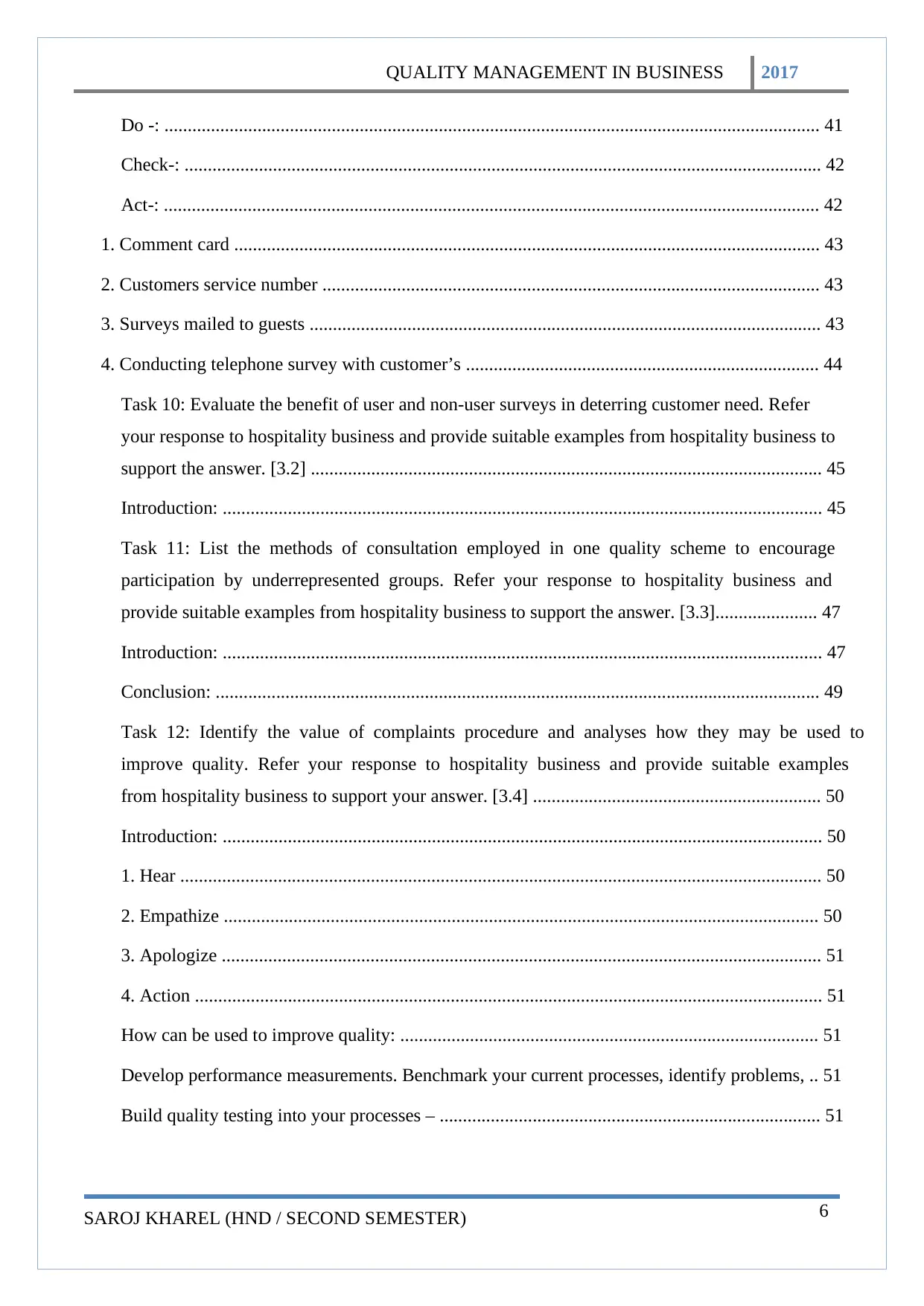
QUALITY MANAGEMENT IN BUSINESS 2017
SAROJ KHAREL (HND / SECOND SEMESTER) 6
Do -: ............................................................................................................................................. 41
Check-: ......................................................................................................................................... 42
Act-: ............................................................................................................................................. 42
1. Comment card .............................................................................................................................. 43
2. Customers service number ........................................................................................................... 43
3. Surveys mailed to guests .............................................................................................................. 43
4. Conducting telephone survey with customer’s ............................................................................ 44
Task 10: Evaluate the benefit of user and non-user surveys in deterring customer need. Refer
your response to hospitality business and provide suitable examples from hospitality business to
support the answer. [3.2] .............................................................................................................. 45
Introduction: ................................................................................................................................. 45
Task 11: List the methods of consultation employed in one quality scheme to encourage
participation by underrepresented groups. Refer your response to hospitality business and
provide suitable examples from hospitality business to support the answer. [3.3]...................... 47
Introduction: ................................................................................................................................. 47
Conclusion: .................................................................................................................................. 49
Task 12: Identify the value of complaints procedure and analyses how they may be used to
improve quality. Refer your response to hospitality business and provide suitable examples
from hospitality business to support your answer. [3.4] .............................................................. 50
Introduction: ................................................................................................................................. 50
1. Hear .......................................................................................................................................... 50
2. Empathize ................................................................................................................................ 50
3. Apologize ................................................................................................................................. 51
4. Action ....................................................................................................................................... 51
How can be used to improve quality: .......................................................................................... 51
Develop performance measurements. Benchmark your current processes, identify problems, .. 51
Build quality testing into your processes – .................................................................................. 51
SAROJ KHAREL (HND / SECOND SEMESTER) 6
Do -: ............................................................................................................................................. 41
Check-: ......................................................................................................................................... 42
Act-: ............................................................................................................................................. 42
1. Comment card .............................................................................................................................. 43
2. Customers service number ........................................................................................................... 43
3. Surveys mailed to guests .............................................................................................................. 43
4. Conducting telephone survey with customer’s ............................................................................ 44
Task 10: Evaluate the benefit of user and non-user surveys in deterring customer need. Refer
your response to hospitality business and provide suitable examples from hospitality business to
support the answer. [3.2] .............................................................................................................. 45
Introduction: ................................................................................................................................. 45
Task 11: List the methods of consultation employed in one quality scheme to encourage
participation by underrepresented groups. Refer your response to hospitality business and
provide suitable examples from hospitality business to support the answer. [3.3]...................... 47
Introduction: ................................................................................................................................. 47
Conclusion: .................................................................................................................................. 49
Task 12: Identify the value of complaints procedure and analyses how they may be used to
improve quality. Refer your response to hospitality business and provide suitable examples
from hospitality business to support your answer. [3.4] .............................................................. 50
Introduction: ................................................................................................................................. 50
1. Hear .......................................................................................................................................... 50
2. Empathize ................................................................................................................................ 50
3. Apologize ................................................................................................................................. 51
4. Action ....................................................................................................................................... 51
How can be used to improve quality: .......................................................................................... 51
Develop performance measurements. Benchmark your current processes, identify problems, .. 51
Build quality testing into your processes – .................................................................................. 51
⊘ This is a preview!⊘
Do you want full access?
Subscribe today to unlock all pages.

Trusted by 1+ million students worldwide
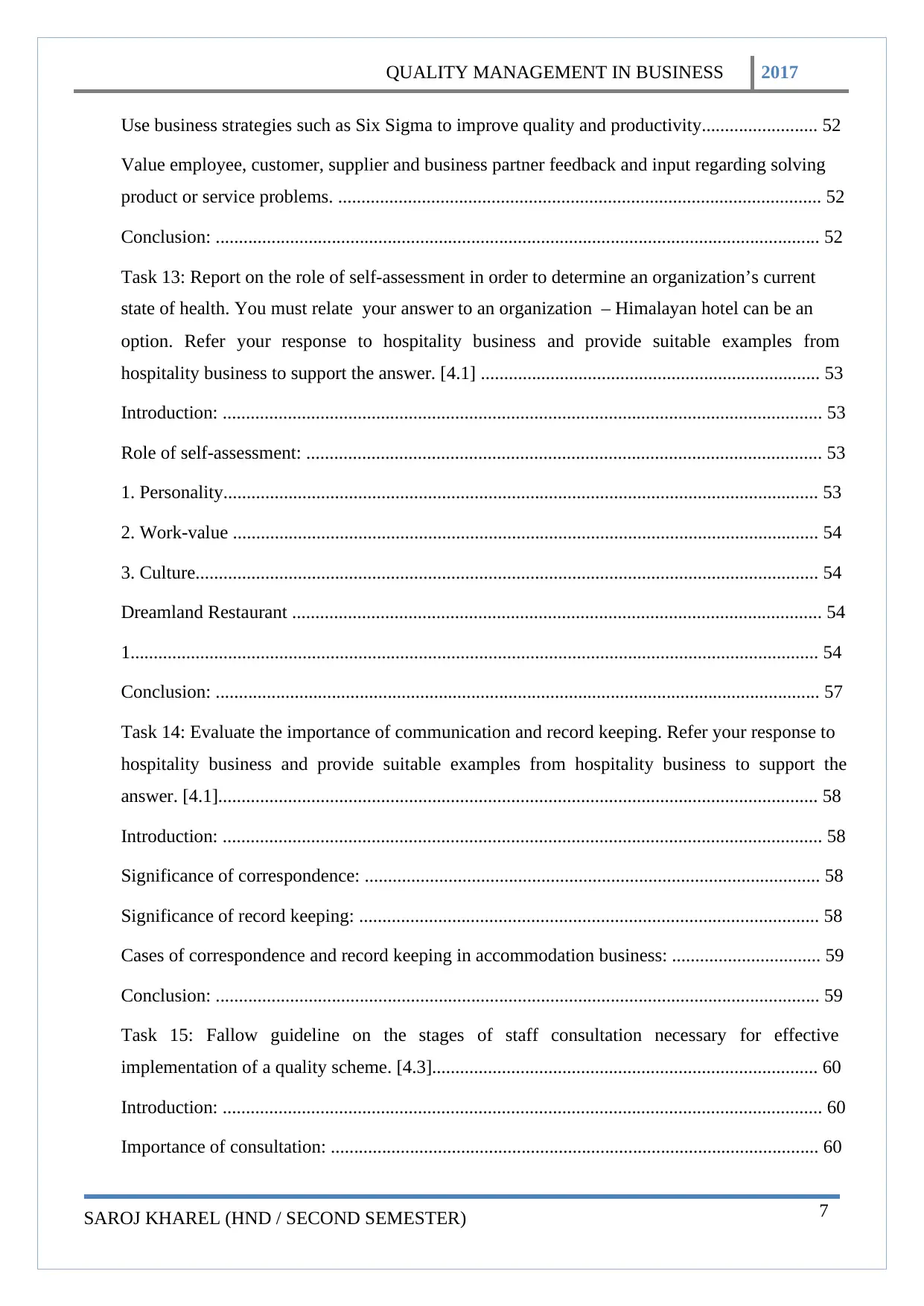
QUALITY MANAGEMENT IN BUSINESS 2017
SAROJ KHAREL (HND / SECOND SEMESTER) 7
Use business strategies such as Six Sigma to improve quality and productivity......................... 52
Value employee, customer, supplier and business partner feedback and input regarding solving
product or service problems. ........................................................................................................ 52
Conclusion: .................................................................................................................................. 52
Task 13: Report on the role of self-assessment in order to determine an organization’s current
state of health. You must relate your answer to an organization – Himalayan hotel can be an
option. Refer your response to hospitality business and provide suitable examples from
hospitality business to support the answer. [4.1] ......................................................................... 53
Introduction: ................................................................................................................................. 53
Role of self-assessment: ............................................................................................................... 53
1. Personality................................................................................................................................ 53
2. Work-value .............................................................................................................................. 54
3. Culture...................................................................................................................................... 54
Dreamland Restaurant .................................................................................................................. 54
1.................................................................................................................................................... 54
Conclusion: .................................................................................................................................. 57
Task 14: Evaluate the importance of communication and record keeping. Refer your response to
hospitality business and provide suitable examples from hospitality business to support the
answer. [4.1]................................................................................................................................. 58
Introduction: ................................................................................................................................. 58
Significance of correspondence: .................................................................................................. 58
Significance of record keeping: ................................................................................................... 58
Cases of correspondence and record keeping in accommodation business: ................................ 59
Conclusion: .................................................................................................................................. 59
Task 15: Fallow guideline on the stages of staff consultation necessary for effective
implementation of a quality scheme. [4.3]................................................................................... 60
Introduction: ................................................................................................................................. 60
Importance of consultation: ......................................................................................................... 60
SAROJ KHAREL (HND / SECOND SEMESTER) 7
Use business strategies such as Six Sigma to improve quality and productivity......................... 52
Value employee, customer, supplier and business partner feedback and input regarding solving
product or service problems. ........................................................................................................ 52
Conclusion: .................................................................................................................................. 52
Task 13: Report on the role of self-assessment in order to determine an organization’s current
state of health. You must relate your answer to an organization – Himalayan hotel can be an
option. Refer your response to hospitality business and provide suitable examples from
hospitality business to support the answer. [4.1] ......................................................................... 53
Introduction: ................................................................................................................................. 53
Role of self-assessment: ............................................................................................................... 53
1. Personality................................................................................................................................ 53
2. Work-value .............................................................................................................................. 54
3. Culture...................................................................................................................................... 54
Dreamland Restaurant .................................................................................................................. 54
1.................................................................................................................................................... 54
Conclusion: .................................................................................................................................. 57
Task 14: Evaluate the importance of communication and record keeping. Refer your response to
hospitality business and provide suitable examples from hospitality business to support the
answer. [4.1]................................................................................................................................. 58
Introduction: ................................................................................................................................. 58
Significance of correspondence: .................................................................................................. 58
Significance of record keeping: ................................................................................................... 58
Cases of correspondence and record keeping in accommodation business: ................................ 59
Conclusion: .................................................................................................................................. 59
Task 15: Fallow guideline on the stages of staff consultation necessary for effective
implementation of a quality scheme. [4.3]................................................................................... 60
Introduction: ................................................................................................................................. 60
Importance of consultation: ......................................................................................................... 60
Paraphrase This Document
Need a fresh take? Get an instant paraphrase of this document with our AI Paraphraser
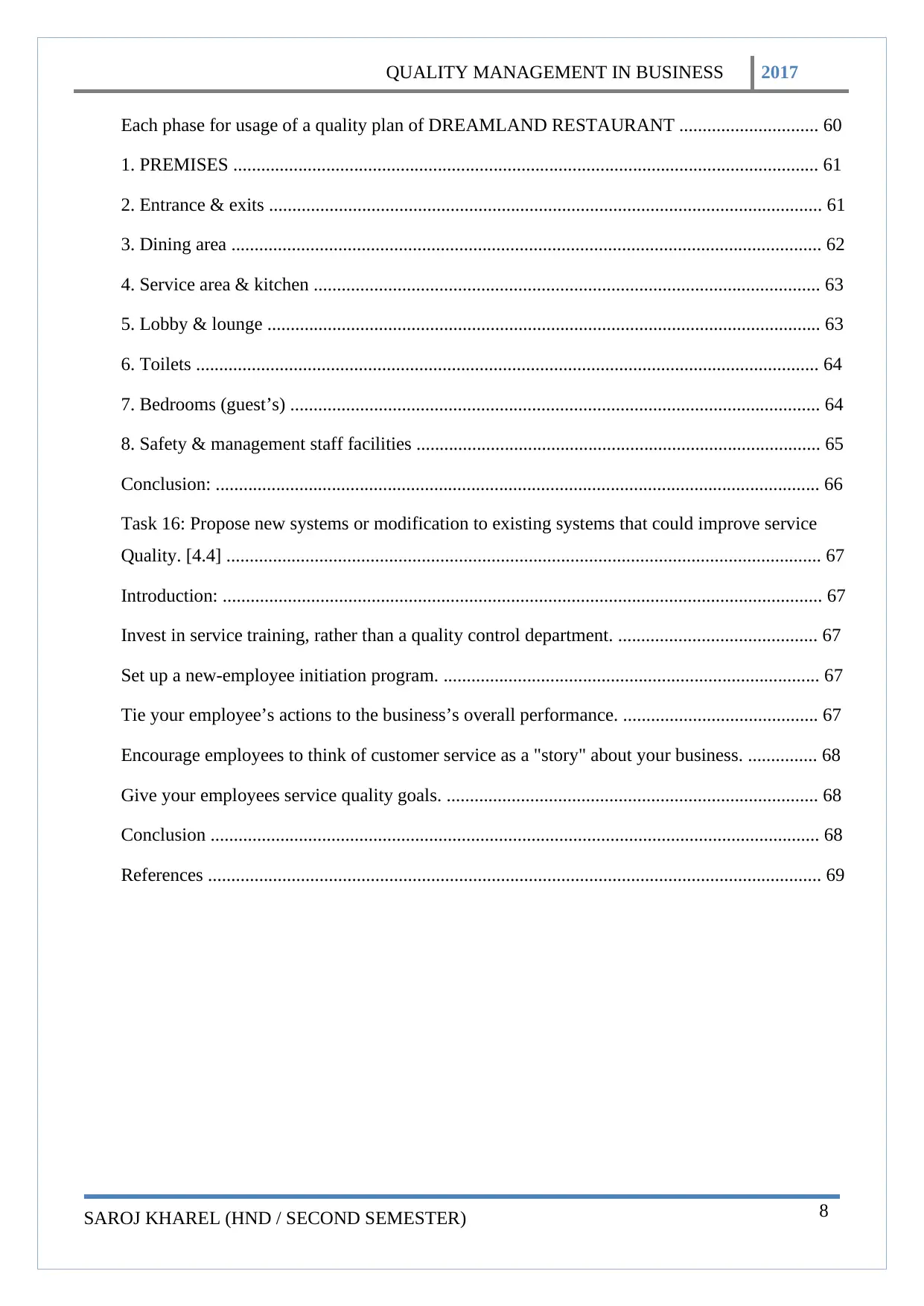
QUALITY MANAGEMENT IN BUSINESS 2017
SAROJ KHAREL (HND / SECOND SEMESTER) 8
Each phase for usage of a quality plan of DREAMLAND RESTAURANT .............................. 60
1. PREMISES .............................................................................................................................. 61
2. Entrance & exits ....................................................................................................................... 61
3. Dining area ............................................................................................................................... 62
4. Service area & kitchen ............................................................................................................. 63
5. Lobby & lounge ....................................................................................................................... 63
6. Toilets ...................................................................................................................................... 64
7. Bedrooms (guest’s) .................................................................................................................. 64
8. Safety & management staff facilities ....................................................................................... 65
Conclusion: .................................................................................................................................. 66
Task 16: Propose new systems or modification to existing systems that could improve service
Quality. [4.4] ................................................................................................................................ 67
Introduction: ................................................................................................................................. 67
Invest in service training, rather than a quality control department. ........................................... 67
Set up a new-employee initiation program. ................................................................................. 67
Tie your employee’s actions to the business’s overall performance. .......................................... 67
Encourage employees to think of customer service as a "story" about your business. ............... 68
Give your employees service quality goals. ................................................................................ 68
Conclusion ................................................................................................................................... 68
References .................................................................................................................................... 69
SAROJ KHAREL (HND / SECOND SEMESTER) 8
Each phase for usage of a quality plan of DREAMLAND RESTAURANT .............................. 60
1. PREMISES .............................................................................................................................. 61
2. Entrance & exits ....................................................................................................................... 61
3. Dining area ............................................................................................................................... 62
4. Service area & kitchen ............................................................................................................. 63
5. Lobby & lounge ....................................................................................................................... 63
6. Toilets ...................................................................................................................................... 64
7. Bedrooms (guest’s) .................................................................................................................. 64
8. Safety & management staff facilities ....................................................................................... 65
Conclusion: .................................................................................................................................. 66
Task 16: Propose new systems or modification to existing systems that could improve service
Quality. [4.4] ................................................................................................................................ 67
Introduction: ................................................................................................................................. 67
Invest in service training, rather than a quality control department. ........................................... 67
Set up a new-employee initiation program. ................................................................................. 67
Tie your employee’s actions to the business’s overall performance. .......................................... 67
Encourage employees to think of customer service as a "story" about your business. ............... 68
Give your employees service quality goals. ................................................................................ 68
Conclusion ................................................................................................................................... 68
References .................................................................................................................................... 69
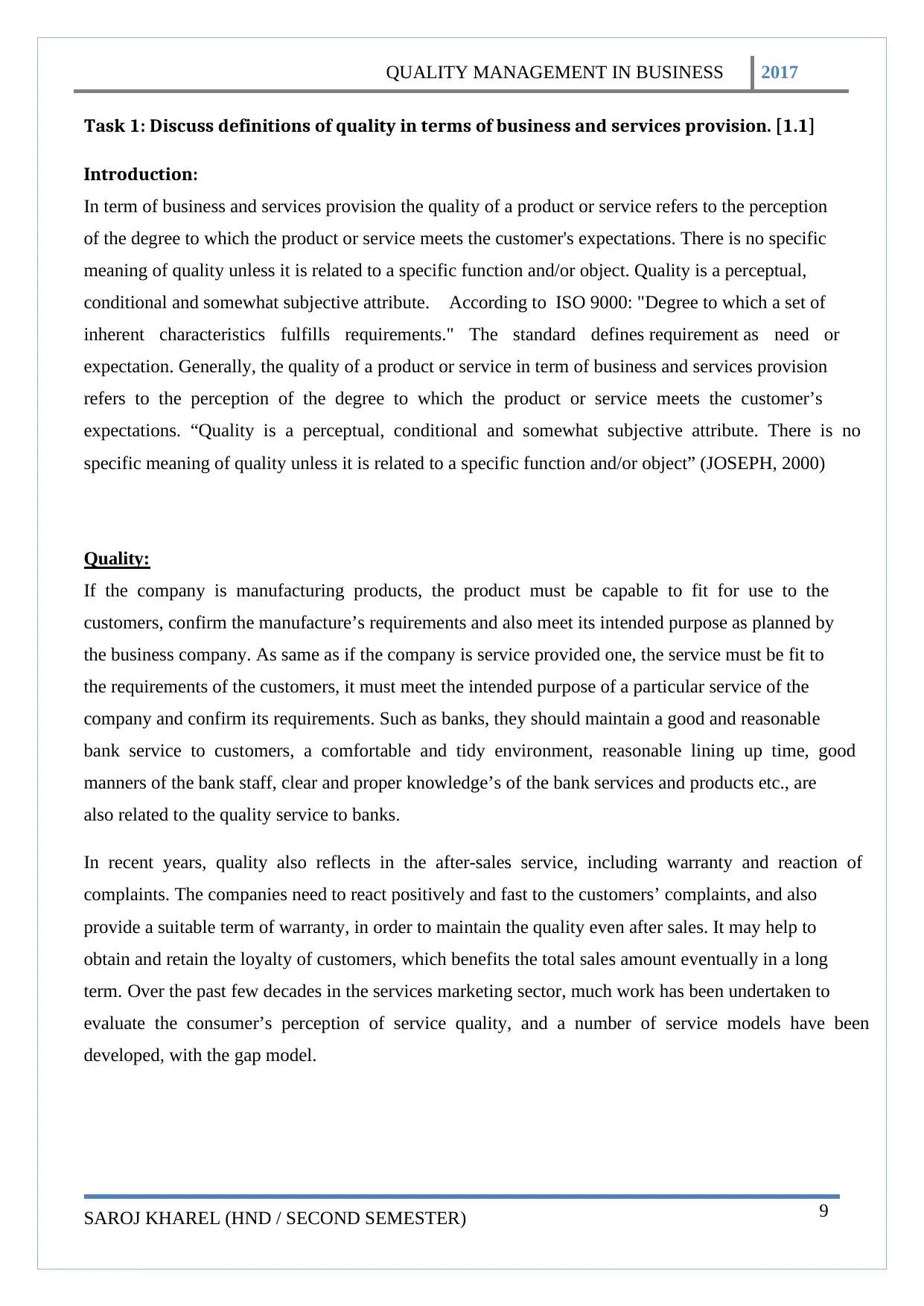
QUALITY MANAGEMENT IN BUSINESS 2017
SAROJ KHAREL (HND / SECOND SEMESTER) 9
Task 1: Discuss definitions of quality in terms of business and services provision. [1.1]
Introduction:
In term of business and services provision the quality of a product or service refers to the perception
of the degree to which the product or service meets the customer's expectations. There is no specific
meaning of quality unless it is related to a specific function and/or object. Quality is a perceptual,
conditional and somewhat subjective attribute. According to ISO 9000: "Degree to which a set of
inherent characteristics fulfills requirements." The standard defines requirement as need or
expectation. Generally, the quality of a product or service in term of business and services provision
refers to the perception of the degree to which the product or service meets the customer’s
expectations. “Quality is a perceptual, conditional and somewhat subjective attribute. There is no
specific meaning of quality unless it is related to a specific function and/or object” (JOSEPH, 2000)
Quality:
If the company is manufacturing products, the product must be capable to fit for use to the
customers, confirm the manufacture’s requirements and also meet its intended purpose as planned by
the business company. As same as if the company is service provided one, the service must be fit to
the requirements of the customers, it must meet the intended purpose of a particular service of the
company and confirm its requirements. Such as banks, they should maintain a good and reasonable
bank service to customers, a comfortable and tidy environment, reasonable lining up time, good
manners of the bank staff, clear and proper knowledge’s of the bank services and products etc., are
also related to the quality service to banks.
In recent years, quality also reflects in the after-sales service, including warranty and reaction of
complaints. The companies need to react positively and fast to the customers’ complaints, and also
provide a suitable term of warranty, in order to maintain the quality even after sales. It may help to
obtain and retain the loyalty of customers, which benefits the total sales amount eventually in a long
term. Over the past few decades in the services marketing sector, much work has been undertaken to
evaluate the consumer’s perception of service quality, and a number of service models have been
developed, with the gap model.
SAROJ KHAREL (HND / SECOND SEMESTER) 9
Task 1: Discuss definitions of quality in terms of business and services provision. [1.1]
Introduction:
In term of business and services provision the quality of a product or service refers to the perception
of the degree to which the product or service meets the customer's expectations. There is no specific
meaning of quality unless it is related to a specific function and/or object. Quality is a perceptual,
conditional and somewhat subjective attribute. According to ISO 9000: "Degree to which a set of
inherent characteristics fulfills requirements." The standard defines requirement as need or
expectation. Generally, the quality of a product or service in term of business and services provision
refers to the perception of the degree to which the product or service meets the customer’s
expectations. “Quality is a perceptual, conditional and somewhat subjective attribute. There is no
specific meaning of quality unless it is related to a specific function and/or object” (JOSEPH, 2000)
Quality:
If the company is manufacturing products, the product must be capable to fit for use to the
customers, confirm the manufacture’s requirements and also meet its intended purpose as planned by
the business company. As same as if the company is service provided one, the service must be fit to
the requirements of the customers, it must meet the intended purpose of a particular service of the
company and confirm its requirements. Such as banks, they should maintain a good and reasonable
bank service to customers, a comfortable and tidy environment, reasonable lining up time, good
manners of the bank staff, clear and proper knowledge’s of the bank services and products etc., are
also related to the quality service to banks.
In recent years, quality also reflects in the after-sales service, including warranty and reaction of
complaints. The companies need to react positively and fast to the customers’ complaints, and also
provide a suitable term of warranty, in order to maintain the quality even after sales. It may help to
obtain and retain the loyalty of customers, which benefits the total sales amount eventually in a long
term. Over the past few decades in the services marketing sector, much work has been undertaken to
evaluate the consumer’s perception of service quality, and a number of service models have been
developed, with the gap model.
⊘ This is a preview!⊘
Do you want full access?
Subscribe today to unlock all pages.

Trusted by 1+ million students worldwide
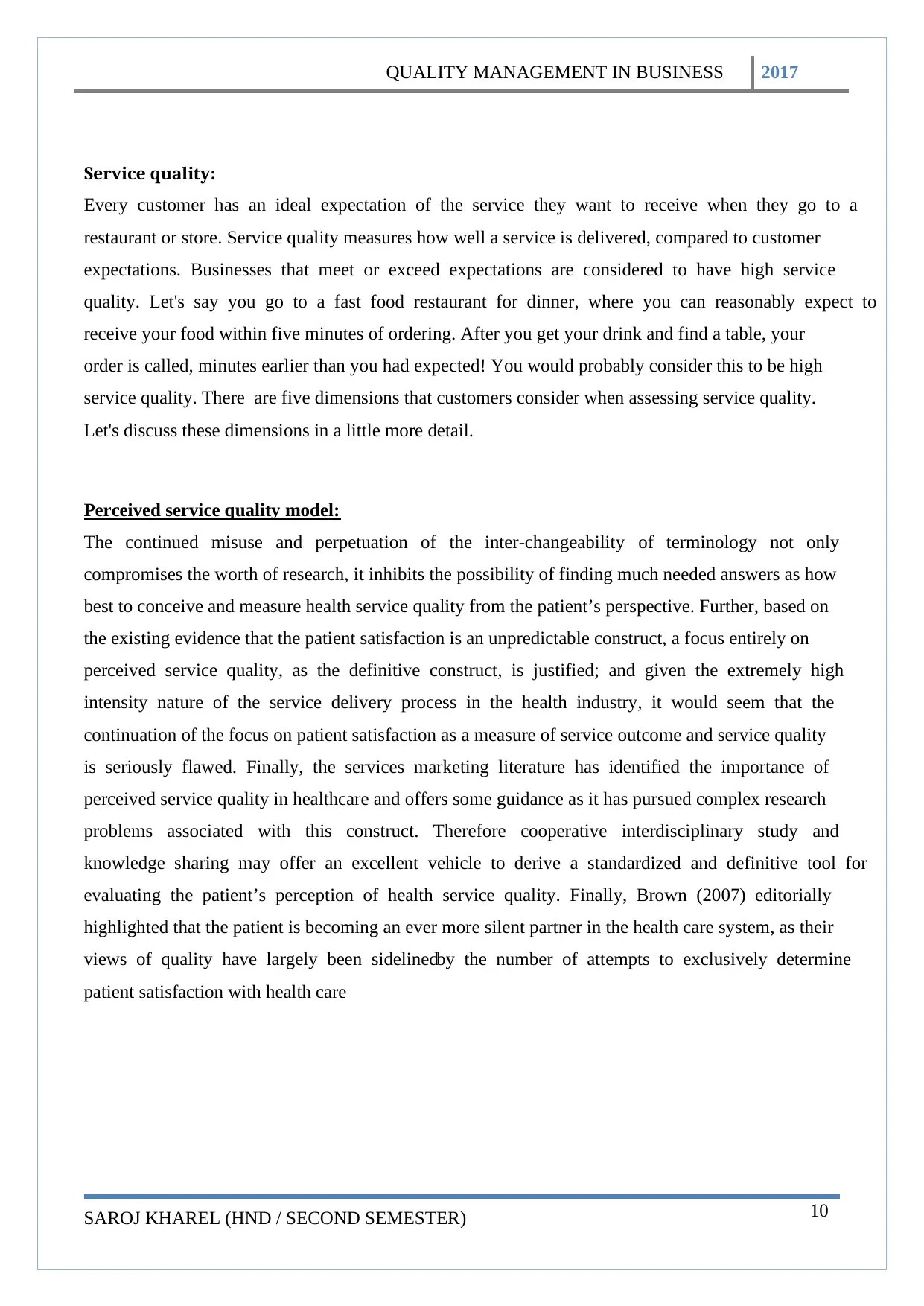
QUALITY MANAGEMENT IN BUSINESS 2017
SAROJ KHAREL (HND / SECOND SEMESTER) 10
Service quality:
Every customer has an ideal expectation of the service they want to receive when they go to a
restaurant or store. Service quality measures how well a service is delivered, compared to customer
expectations. Businesses that meet or exceed expectations are considered to have high service
quality. Let's say you go to a fast food restaurant for dinner, where you can reasonably expect to
receive your food within five minutes of ordering. After you get your drink and find a table, your
order is called, minutes earlier than you had expected! You would probably consider this to be high
service quality. There are five dimensions that customers consider when assessing service quality.
Let's discuss these dimensions in a little more detail.
Perceived service quality model:
The continued misuse and perpetuation of the inter-changeability of terminology not only
compromises the worth of research, it inhibits the possibility of finding much needed answers as how
best to conceive and measure health service quality from the patient’s perspective. Further, based on
the existing evidence that the patient satisfaction is an unpredictable construct, a focus entirely on
perceived service quality, as the definitive construct, is justified; and given the extremely high
intensity nature of the service delivery process in the health industry, it would seem that the
continuation of the focus on patient satisfaction as a measure of service outcome and service quality
is seriously flawed. Finally, the services marketing literature has identified the importance of
perceived service quality in healthcare and offers some guidance as it has pursued complex research
problems associated with this construct. Therefore cooperative interdisciplinary study and
knowledge sharing may offer an excellent vehicle to derive a standardized and definitive tool for
evaluating the patient’s perception of health service quality. Finally, Brown (2007) editorially
highlighted that the patient is becoming an ever more silent partner in the health care system, as their
views of quality have largely been sidelinedby the number of attempts to exclusively determine
patient satisfaction with health care
SAROJ KHAREL (HND / SECOND SEMESTER) 10
Service quality:
Every customer has an ideal expectation of the service they want to receive when they go to a
restaurant or store. Service quality measures how well a service is delivered, compared to customer
expectations. Businesses that meet or exceed expectations are considered to have high service
quality. Let's say you go to a fast food restaurant for dinner, where you can reasonably expect to
receive your food within five minutes of ordering. After you get your drink and find a table, your
order is called, minutes earlier than you had expected! You would probably consider this to be high
service quality. There are five dimensions that customers consider when assessing service quality.
Let's discuss these dimensions in a little more detail.
Perceived service quality model:
The continued misuse and perpetuation of the inter-changeability of terminology not only
compromises the worth of research, it inhibits the possibility of finding much needed answers as how
best to conceive and measure health service quality from the patient’s perspective. Further, based on
the existing evidence that the patient satisfaction is an unpredictable construct, a focus entirely on
perceived service quality, as the definitive construct, is justified; and given the extremely high
intensity nature of the service delivery process in the health industry, it would seem that the
continuation of the focus on patient satisfaction as a measure of service outcome and service quality
is seriously flawed. Finally, the services marketing literature has identified the importance of
perceived service quality in healthcare and offers some guidance as it has pursued complex research
problems associated with this construct. Therefore cooperative interdisciplinary study and
knowledge sharing may offer an excellent vehicle to derive a standardized and definitive tool for
evaluating the patient’s perception of health service quality. Finally, Brown (2007) editorially
highlighted that the patient is becoming an ever more silent partner in the health care system, as their
views of quality have largely been sidelinedby the number of attempts to exclusively determine
patient satisfaction with health care
Paraphrase This Document
Need a fresh take? Get an instant paraphrase of this document with our AI Paraphraser
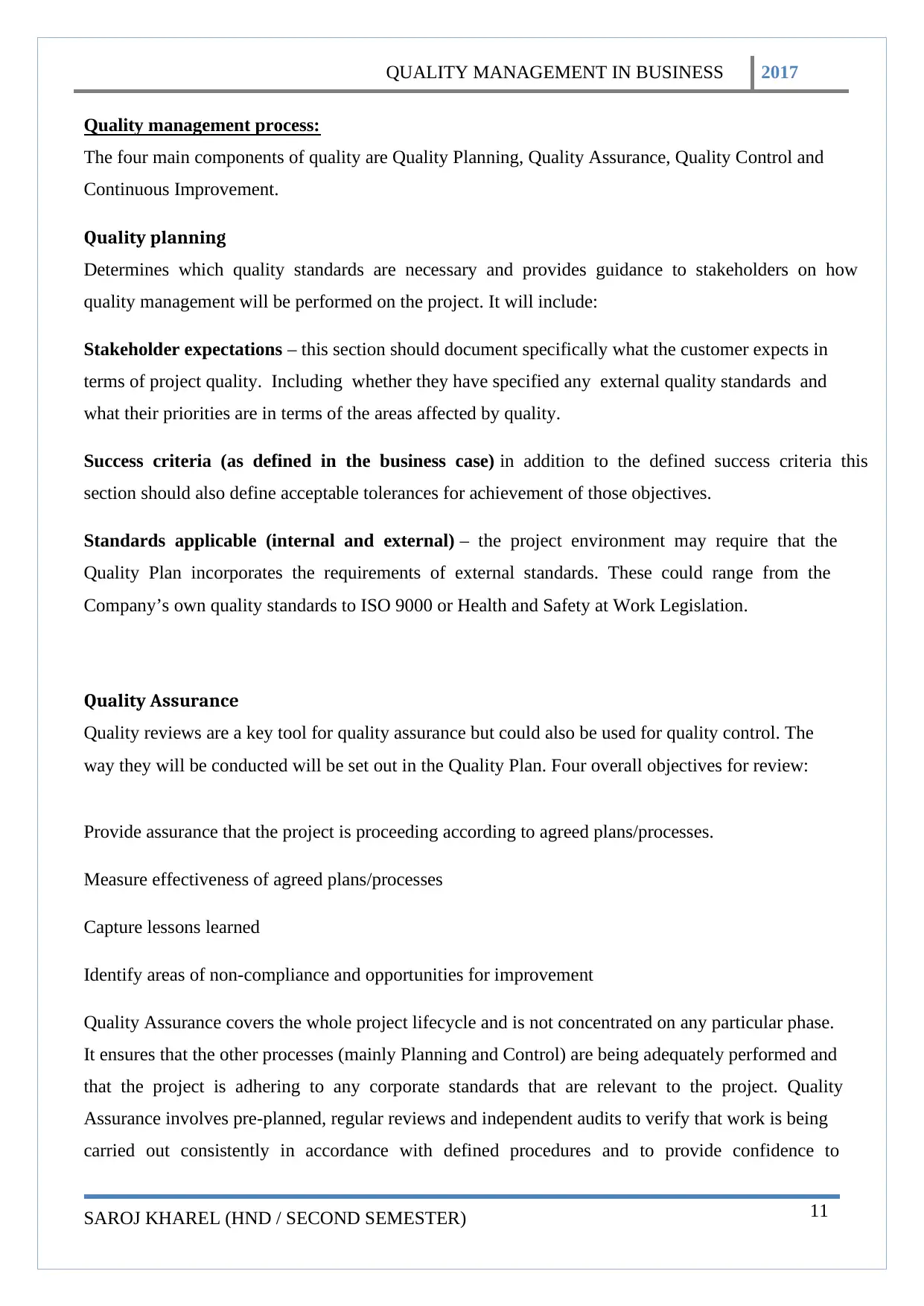
QUALITY MANAGEMENT IN BUSINESS 2017
SAROJ KHAREL (HND / SECOND SEMESTER) 11
Quality management process:
The four main components of quality are Quality Planning, Quality Assurance, Quality Control and
Continuous Improvement.
Quality planning
Determines which quality standards are necessary and provides guidance to stakeholders on how
quality management will be performed on the project. It will include:
Stakeholder expectations – this section should document specifically what the customer expects in
terms of project quality. Including whether they have specified any external quality standards and
what their priorities are in terms of the areas affected by quality.
Success criteria (as defined in the business case) in addition to the defined success criteria this
section should also define acceptable tolerances for achievement of those objectives.
Standards applicable (internal and external) – the project environment may require that the
Quality Plan incorporates the requirements of external standards. These could range from the
Company’s own quality standards to ISO 9000 or Health and Safety at Work Legislation.
Quality Assurance
Quality reviews are a key tool for quality assurance but could also be used for quality control. The
way they will be conducted will be set out in the Quality Plan. Four overall objectives for review:
Provide assurance that the project is proceeding according to agreed plans/processes.
Measure effectiveness of agreed plans/processes
Capture lessons learned
Identify areas of non-compliance and opportunities for improvement
Quality Assurance covers the whole project lifecycle and is not concentrated on any particular phase.
It ensures that the other processes (mainly Planning and Control) are being adequately performed and
that the project is adhering to any corporate standards that are relevant to the project. Quality
Assurance involves pre-planned, regular reviews and independent audits to verify that work is being
carried out consistently in accordance with defined procedures and to provide confidence to
SAROJ KHAREL (HND / SECOND SEMESTER) 11
Quality management process:
The four main components of quality are Quality Planning, Quality Assurance, Quality Control and
Continuous Improvement.
Quality planning
Determines which quality standards are necessary and provides guidance to stakeholders on how
quality management will be performed on the project. It will include:
Stakeholder expectations – this section should document specifically what the customer expects in
terms of project quality. Including whether they have specified any external quality standards and
what their priorities are in terms of the areas affected by quality.
Success criteria (as defined in the business case) in addition to the defined success criteria this
section should also define acceptable tolerances for achievement of those objectives.
Standards applicable (internal and external) – the project environment may require that the
Quality Plan incorporates the requirements of external standards. These could range from the
Company’s own quality standards to ISO 9000 or Health and Safety at Work Legislation.
Quality Assurance
Quality reviews are a key tool for quality assurance but could also be used for quality control. The
way they will be conducted will be set out in the Quality Plan. Four overall objectives for review:
Provide assurance that the project is proceeding according to agreed plans/processes.
Measure effectiveness of agreed plans/processes
Capture lessons learned
Identify areas of non-compliance and opportunities for improvement
Quality Assurance covers the whole project lifecycle and is not concentrated on any particular phase.
It ensures that the other processes (mainly Planning and Control) are being adequately performed and
that the project is adhering to any corporate standards that are relevant to the project. Quality
Assurance involves pre-planned, regular reviews and independent audits to verify that work is being
carried out consistently in accordance with defined procedures and to provide confidence to
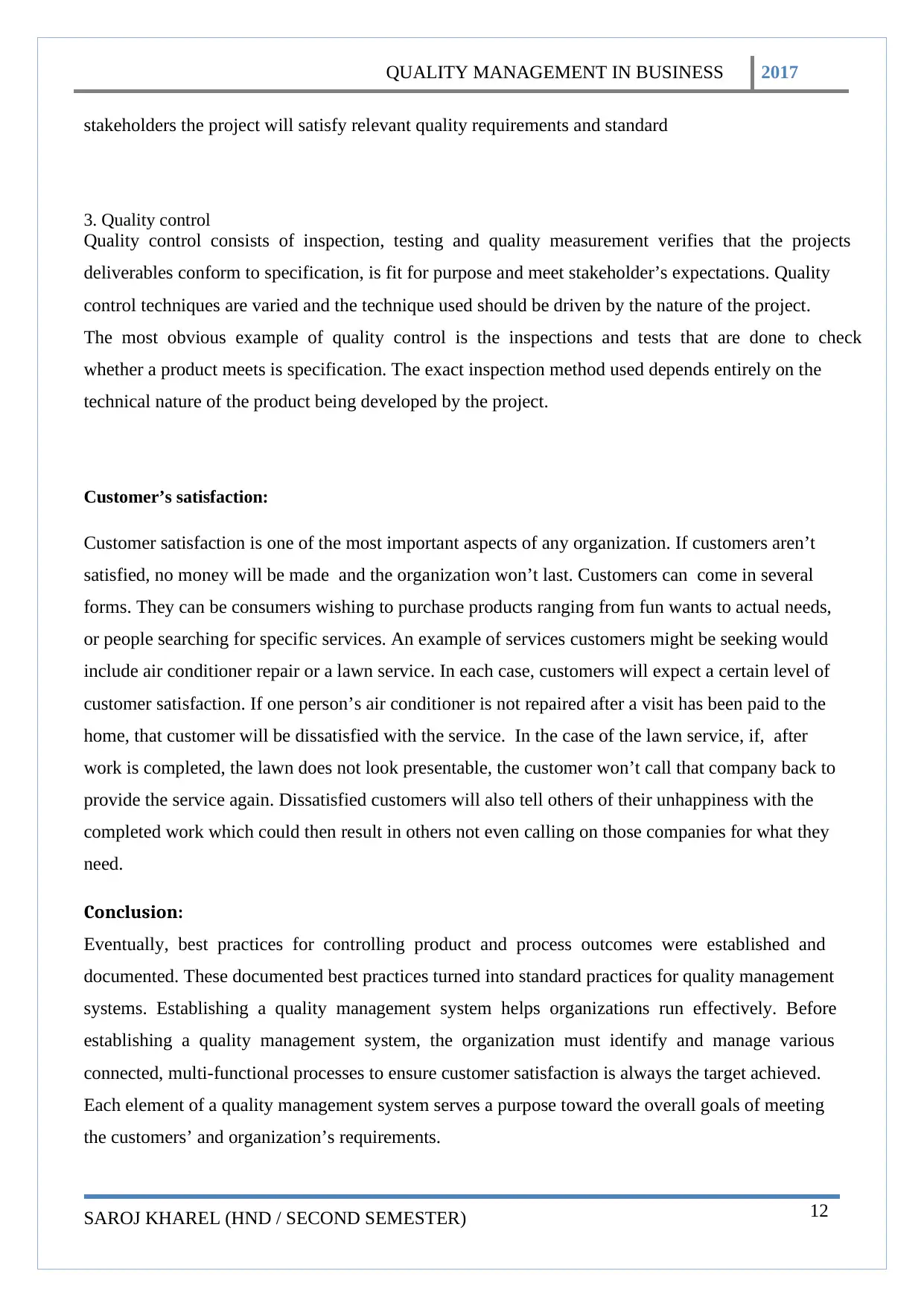
QUALITY MANAGEMENT IN BUSINESS 2017
SAROJ KHAREL (HND / SECOND SEMESTER) 12
stakeholders the project will satisfy relevant quality requirements and standard
3. Quality control
Quality control consists of inspection, testing and quality measurement verifies that the projects
deliverables conform to specification, is fit for purpose and meet stakeholder’s expectations. Quality
control techniques are varied and the technique used should be driven by the nature of the project.
The most obvious example of quality control is the inspections and tests that are done to check
whether a product meets is specification. The exact inspection method used depends entirely on the
technical nature of the product being developed by the project.
Customer’s satisfaction:
Customer satisfaction is one of the most important aspects of any organization. If customers aren’t
satisfied, no money will be made and the organization won’t last. Customers can come in several
forms. They can be consumers wishing to purchase products ranging from fun wants to actual needs,
or people searching for specific services. An example of services customers might be seeking would
include air conditioner repair or a lawn service. In each case, customers will expect a certain level of
customer satisfaction. If one person’s air conditioner is not repaired after a visit has been paid to the
home, that customer will be dissatisfied with the service. In the case of the lawn service, if, after
work is completed, the lawn does not look presentable, the customer won’t call that company back to
provide the service again. Dissatisfied customers will also tell others of their unhappiness with the
completed work which could then result in others not even calling on those companies for what they
need.
Conclusion:
Eventually, best practices for controlling product and process outcomes were established and
documented. These documented best practices turned into standard practices for quality management
systems. Establishing a quality management system helps organizations run effectively. Before
establishing a quality management system, the organization must identify and manage various
connected, multi-functional processes to ensure customer satisfaction is always the target achieved.
Each element of a quality management system serves a purpose toward the overall goals of meeting
the customers’ and organization’s requirements.
SAROJ KHAREL (HND / SECOND SEMESTER) 12
stakeholders the project will satisfy relevant quality requirements and standard
3. Quality control
Quality control consists of inspection, testing and quality measurement verifies that the projects
deliverables conform to specification, is fit for purpose and meet stakeholder’s expectations. Quality
control techniques are varied and the technique used should be driven by the nature of the project.
The most obvious example of quality control is the inspections and tests that are done to check
whether a product meets is specification. The exact inspection method used depends entirely on the
technical nature of the product being developed by the project.
Customer’s satisfaction:
Customer satisfaction is one of the most important aspects of any organization. If customers aren’t
satisfied, no money will be made and the organization won’t last. Customers can come in several
forms. They can be consumers wishing to purchase products ranging from fun wants to actual needs,
or people searching for specific services. An example of services customers might be seeking would
include air conditioner repair or a lawn service. In each case, customers will expect a certain level of
customer satisfaction. If one person’s air conditioner is not repaired after a visit has been paid to the
home, that customer will be dissatisfied with the service. In the case of the lawn service, if, after
work is completed, the lawn does not look presentable, the customer won’t call that company back to
provide the service again. Dissatisfied customers will also tell others of their unhappiness with the
completed work which could then result in others not even calling on those companies for what they
need.
Conclusion:
Eventually, best practices for controlling product and process outcomes were established and
documented. These documented best practices turned into standard practices for quality management
systems. Establishing a quality management system helps organizations run effectively. Before
establishing a quality management system, the organization must identify and manage various
connected, multi-functional processes to ensure customer satisfaction is always the target achieved.
Each element of a quality management system serves a purpose toward the overall goals of meeting
the customers’ and organization’s requirements.
⊘ This is a preview!⊘
Do you want full access?
Subscribe today to unlock all pages.

Trusted by 1+ million students worldwide
1 out of 73
Related Documents
Your All-in-One AI-Powered Toolkit for Academic Success.
+13062052269
info@desklib.com
Available 24*7 on WhatsApp / Email
![[object Object]](/_next/static/media/star-bottom.7253800d.svg)
Unlock your academic potential
Copyright © 2020–2025 A2Z Services. All Rights Reserved. Developed and managed by ZUCOL.





